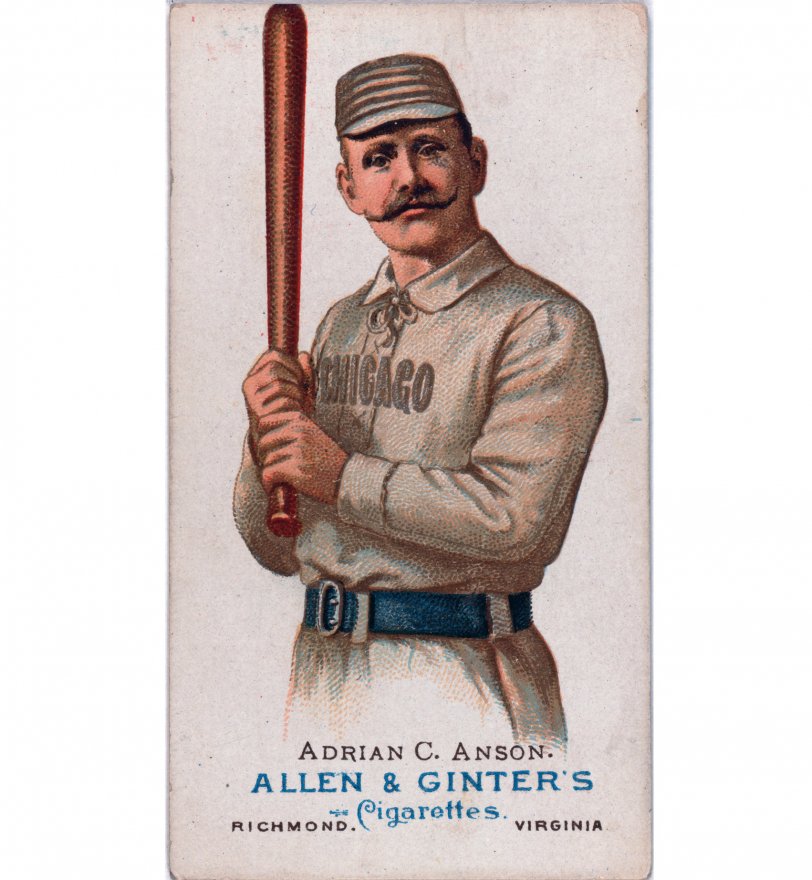 Well, I’m not actually sure this blog title is entirely true, and that’s why I can freely publish it here. I found this 1887 baseball card on Shorpy’s Photo blog. It features the likeness of Chicago White Stockings first baseman Adrian C. Anson (also known as Cap Anson).
Well, I’m not actually sure this blog title is entirely true, and that’s why I can freely publish it here. I found this 1887 baseball card on Shorpy’s Photo blog. It features the likeness of Chicago White Stockings first baseman Adrian C. Anson (also known as Cap Anson).
An early baseball card like this is in and of itself interesting to me, but it is far more amazing just how much history a seemingly inert object contains when coupled with a fascinating comment thread like the one following this image. You can find the comment thread here, and I will encapsulate what I learned from it below:
- Cap Anson was “(common for the era, even in his native Iowa) a bigot. His racial attitudes were stronger than most, however, and he led efforts to exclude blacks from professional baseball.”
- Which is followed by this fascinating bit: “Jackie Robinson was NOT the first black to play in the major leagues — both Fleet and Welday Walker played in 1884 before the color barrier limited baseball to the (ahem) melanin-impaired.”
- Lewis Ginter (of the Allen & Ginter’s Cigarette’s company) was a New Yorker who went to Richmond when he was 18 and became an extremely wealthy and powerful industrialist. Here’s a look at his profile from a user’s comment:
Ginter amassed a great fortune in the tobacco industry via new technology for rolling cigarettes. He used this massive fortune to act as a philanthropist and for the development of civic and business interests in Richmond. He developed the neighborhood Ginter Park and brought the Union Theological Seminary there. His niece Grace Arents continued his philanthropy, spurring the development of St. Andrew’s School, the Instructional Visiting Nurse Association and the Lewis Ginter Botanical Garden at her home Bloemendaal.
Hired on to the John Allen & Co, he became a partner of the Allen and Ginter tobacco company that ushered in a number of innovations including cigarette cards and the use of local Virginia tobacco. In 1890 Ginter’s company joined forces with James B. Duke to form the American Tobacco Co..
- Cap Anson was the first member of the 3,000 hits club, and is currently 7th on the all-time hits leaders. he ended his career broke and in vaudeville (Confession: I learned about his standing on the all-time hits list and his vaudeville career from wikipedia.) There was a controversy surrounding whether or not he should be considered part of the 3,000 hits club given over 400 of his hits were made in the National Association, which some believed could not be considered a major league (see the wikipedia article here for more on this).
- Last, but certainly not least:
I don’t know how commonly known this is, but this photo illustrates the fact that baseball cards were originally introduced in cigarette packs in order to keep the cigarettes from bending over. When they later started getting popular with kids they were packaged with bubble gum.
Now, I’m gonna have to have the bava-factcheckers go over this list to make sure all these points are 100% accurate and absolutely airtight, so until they give the thumbs-up I just wanted to reflect just how amazing it is to see a 120 year old baseball card take on so many rich social, material, biographical, and political inflections. The comment matrix of other people brings this cultural artifact to life. Informal learning at its best and, as usual, it is spurred on by curiosity, connections, and serendipity, not the desire to “get educated,” so to speak.


Nothing like a blog to spread possible lies about the origins of baseball cards hah. I’ll give props to the cigarette companies though if they were the first ones to start it (I still want you to stop smoking though!).
I think I’ll need to check out shorpy’s photo blog, looks like there is a lot of good stuff going on there.
It’s true! Another interesting tobacco card story: Honus Wagner did not want his card used in something promoting smoking to kids so he asked the American Tobacco Company to pull his cards. The Honus Wagner 1909 T 206 is now the most valuable baseball card in the world. Estimates are that between 100-200 were printed and of those supposedly 9 exist (although its hard to say because these cards are usually sold in private auctions). Evidently the last time one of these was sold, it went for nearly $3mil. Lol, for what most people would consider just a piece of cardboard. Sorry to ramble just thought I’d add another interesting story.